
Objective: Our goal is to understand the processes that formed our solar system and to explore the initial conditions that produced the diverse types of bodies in this system. We would then apply this knowledge to understand the possible formation of other solar systems.

Approach: We have developed a numerical simulationoof planetesimal accretion to study the formation of planet-sized bodies from small planetesimals (typically km-sized bodies) (Spaute et al. 1992 [Icarus 92, 177-164], Weidenschilling et al. 1994 [submitted to Icarus]). This numerical model is the first to treat the simultaneous evolution of a number of adjacent zones at different heliocentric distances; earlier models could handle only a single, narrow range of orbital semimajor axes of the planetesimals. Ours is also the first code to employ both a statistical approach (for early stages of accretion when there are large numbers of small planetesimals) and a discrete body algorithm (to treat the case when there are only a few bodies at the large mass end of the size spectrum) where the statistical approach breaks down. The overall goal of our project is to apply this model to study a variety of problems relating to the formation of our planetary systems, such as: i) accretion of planetesimals in both gas-free and gas-rich scenarios, addressing in particular problems of  dynamical isolation of the largest bodies in a planetary zone, ii) effects of orbital resonances with gas drag present on the accretion process, iii) studies of the timescale for formation of the outer planets and the size distribution of cometesimals (the bodies scattered to form the Oort Cloud, which supplies our present comet population).
dynamical isolation of the largest bodies in a planetary zone, ii) effects of orbital resonances with gas drag present on the accretion process, iii) studies of the timescale for formation of the outer planets and the size distribution of cometesimals (the bodies scattered to form the Oort Cloud, which supplies our present comet population).
Accomplishments: Our numerical model was developed for a serial computer, so the first goal has been to port it to a parallel platform. At the same time, we have been restructuring the logic of the code to work more efficiently in a parallel environment. We have been trying two approaches to parallelization: one is to use a data parallel approach for a CM-5 platform, while the other method is to apply a message-passing strategy operating under PVM software. The strategy is to have a competition between these two approaches to understand the strengths and weakness of each method for large scale scientific modeling projects. Currently, we have gotten both approaches to successfully execute our software for planet formation, and are now beginning to optimize the program for each of these approaches. As an example of the output of our code, we show the size and orbit distribution of a swarm of planetesimals in Fig. 1.
Significance: Understanding how our solar system formed will address one of the stated goals of NASA and will give us insight into the conditions necessary for the formation of planets. Applying this to other stellar systems will enable us to better assess the frequency of other solar systems. This type of theoretical work will complement the observational searches that are underway to detect other solar systems.
Status/Plans: In addition to the NRL CM-5 account, we established accounts on the NASA Ames CM-5, the JPL Paragon and an nCUBE located in Pisa, Italy. We plan to test the portability of the code and to do comparative timing tests for our planet forming code, a typical example of a large scale scientific simulation that is computationally limited. We are also interested in developing more effective graphics to demonstrate visually how planets form from a protostellar cloud.
Figure Caption:
The size distribution and orbit element distribution (eccentricity) of a planetesimal swarm at different distances from the Sun after 1 million years of accretion.
Point of Contact:
 Return to the PREVIOUS PAGE
Return to the PREVIOUS PAGE